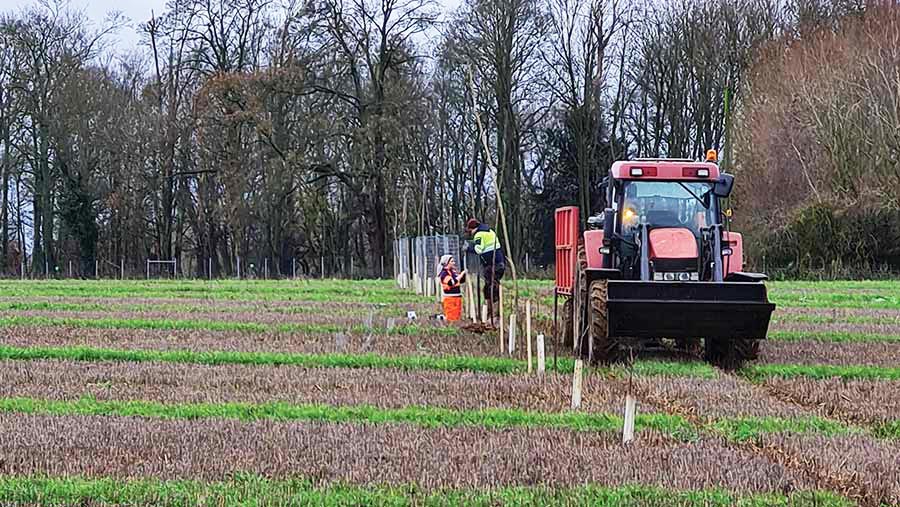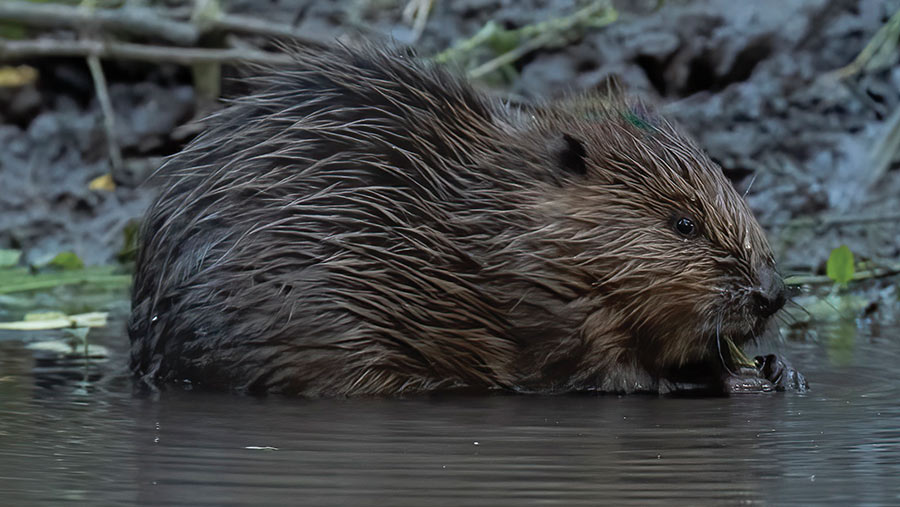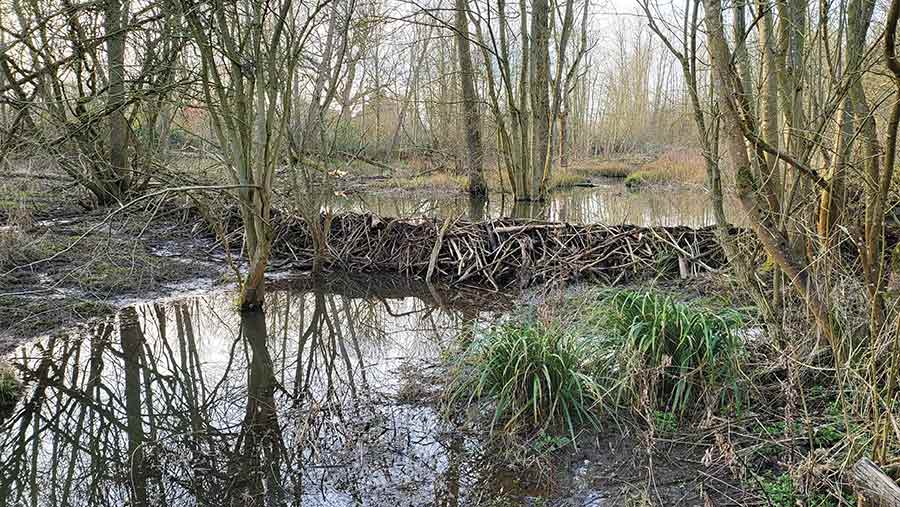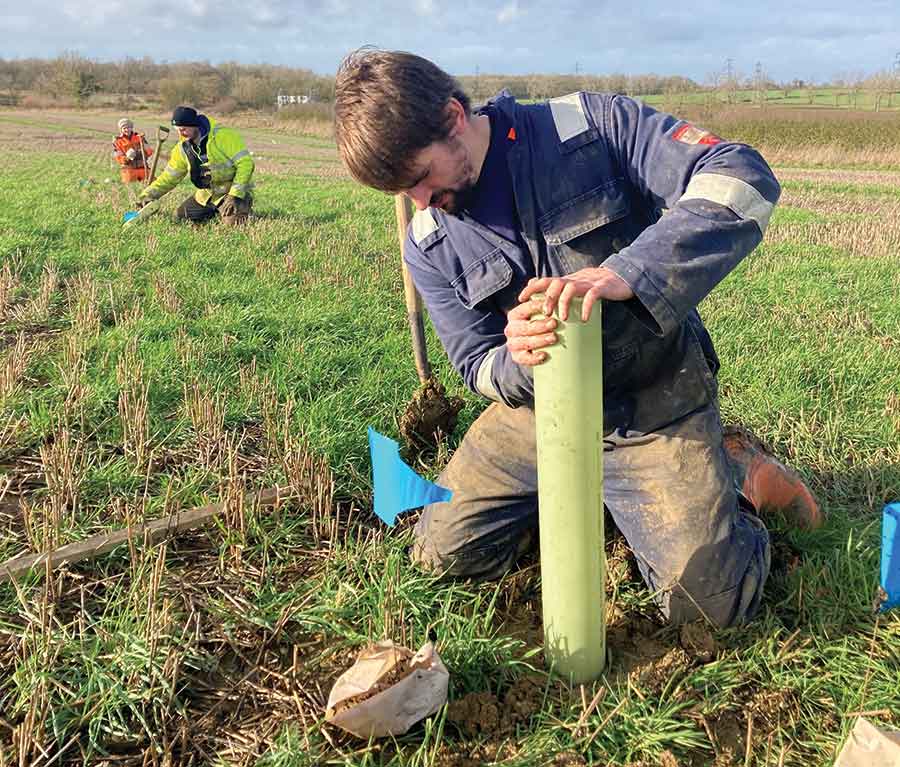Wetlands and agroforestry central to farm’s funding future
 Walnut tree planting © Spains Hall Estate
Walnut tree planting © Spains Hall Estate A move away from conventional arable and food production is underway at Spains Hall Estate.
The combination of agroforestry, woodland and wetlands being created across 500ha will provide ecosystem services and natural water management at scale.
Estate owner Archie Ruggles-Brise says it was clear some years ago that things had to change, as more than half of the estate’s income was based on farm rents and traditional farming practices, while Brexit was on the horizon along with climate and biodiversity crises.
“We needed to reduce our exposure to risk, bring in more diversity and prepare for a less certain but sustainable future,” he says.
See also: Biodiversity net gain agreements – what farmers should know
“With BPS [Basic Payment Scheme] being phased out, moving into in-hand commodity production wasn’t the best way of doing that.”
Natural capital appraisal
A natural capital appraisal completed in 2019 with consultant Atkins provided a baseline, highlighted the risks of the estate continuing as it was and gave an indication of the ecosystem services provision that would result from making changes.
“With our existing arable practices, there was a danger of losing as much as 9t of soil a year,” says Archie. “There were also ammonia emissions and nitrate losses to water to consider.”
The appraisal compared the t/ha output of food that had previously come from the land with the baseline study, as one ecosystem service likely to reduce in future.
A subsequent modelling exercise showed what the estate could achieve through land use change and that it could be viable in its new format, without any arable crop sales.
Potential incomes streams such as biodiversity net gain (BNG), carbon sequestration, productive agroforestry, ecotourism and water were costed, giving different financial priorities and revealing what was possible with these new revenue sources.
“We then became part of Natural England’s BNG Credits pilot,” says Archie. “That enabled us to come up with our masterplan, which was a 30-year projection of habitat provision within a wider integrated landscape.”
Bespoke funding
The biodiversity net gain pilot has only supported scheme preparation work, not the supply of units, so the estate has had to rely on bespoke funding and government schemes, as well as capital grants, as it gathers support for the changes it is making.
While he admits to being brave, Archie Ruggles-Brise is confident about attracting support from those needing to buy biodiversity units and carbon credits, as well as from government agencies.
Countryside Stewardship is an off-the-shelf scheme, but other funding has come following conversations with water companies, local authorities and the Environment Agency – all of whom have come on board for slightly different reasons.
Wetlands
Spains Hall Estate is well-known for its participation in a nature-based project incorporating beavers, which now covers 44ha and has seen wetlands and habitat created along the Finchingfield Brook, with water quality improved.
Released with the support of the Environment Agency in 2019, the beavers are part of a low-cost natural flood management scheme that reduces the flood risk to the village of Finchingfield and helps protect the local community.
After initial success, the estate has recently expanded the project by building a further two beaver enclosures, with the aim of delivering cleaner water, helping wildlife recover and boosting climate resilience.

© Russell Savory/Spains Hall Estate
Apart from slowing the flow, the beavers’ activities help to trap sediment and clean the water, raising the water level in places and encouraging vegetation to mop up excess nutrients.
They are just part of the wider scheme that brings in nature-based solutions to help solve complex issues around water management.
“We know that 23m litres of water could be stored in the beaver wetlands.
“When put together with our other measures, such as ditch and soil management, that helps to increase summer flows by 5-10% and reduce the flood risk to the village by 15-30%.”

© Simon Hurwitz/Spains Hall Estate
The latest round of beaver funding of £350,000 came from a unique public and private partnership including the Environment Agency, the Anglian Eastern Regional Flood and Coastal Committee (RFCC), Anglian Water, Essex County Council and Essex and Suffolk Water.
Agroforestry
Agroforestry is well under way, with 300ha earmarked for the project.
The first 50ha has already been planted, with oak, hazel and walnut trees used in 24m alleys and a large-scale Countryside Stewardship scheme being established in each alley.
These stewardship options will provide funding for five years and add to the habitat on the estate, with measures such as flower-rich mixes for pollen and nectar, herb-rich swards and winter bird food mixes being used.
They have payment rates of about £380/ha to more than £700/ha, depending on the option chosen, for a fixed five-year period.
In time, conservation grazing will be introduced with cattle in some areas, on a non-commercial basis, to increase biodiversity and provide for wildlife.
The development of wood pasture will expand this provision and build soil, helping with carbon capture both above and below ground.
The area being planted with agroforestry is arable land that has recently been taken back in-hand, and with the cost reaching £30/tree, depending on the type of guarding used, there has been some funding from Essex County Council.
Otherwise, in the absence of suitable support schemes, the business is bearing the remainder of the initial costs.
Many of the oak trees were grown from acorns collected from the estate, while others were imported from France to ensure the trees could meet future climate challenges.

Planting oak trees © Spains Hall Estate
Both walnuts and hazelnuts are high-value crops. Archie sees them becoming an income stream as the trees mature, while the oaks will produce a timber crop.
“Unusually for agroforestry, the crop will come from the trees and the alleys will add to the environmental benefits. By using different options and creating various habitats, we are adding to the diversity,” he says.
“Once the Countryside Stewardship agreement has run its course, the trees will be producing. Of course, we could have farmed conventionally between the rows, but that would have taken us back into commodity production.”
Woodland
New woodland is also being created, with a further 17ha of broad-leaved woodland planned for next year. That will add to the 80ha of woodland already on the estate and link it with hedgerows and other areas with wildlife value.
An English Woodland Creation Offer grant will support this, before other income streams – including carbon sequestration – are possible.
“When we put all of these changes together, we will have trees and woodland, plus different types of grassland and wetlands, all in a plan to help with water management,” says Archie.
“It’s a hands-off approach, which will also support biodiversity. We are constantly measuring and monitoring on the estate, through research partnerships, so that we can quantify the impact we are having and show future buyers what they are getting.”
Inheritance tax questions
The availability of inheritance tax reliefs for long-term land use change is still the elephant in the room, especially for 30-year biodiversity net gain agreements, says Archie Ruggles-Brise.
He hopes that by keeping much of the land farmable, with grassland and wood pasture, he will have a potential solution.
Otherwise, he is awaiting government guidance and hopes that any changes made to the current tax system will be helpful.
A consultation on the subject was introduced with this spring’s budget and closed on 9 June.
